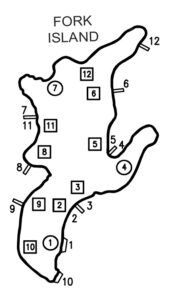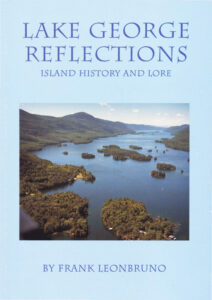12 NYS campsites; in old days, some permanent users; one nude teacher
Editor’s note: This is the 25th anniversary of when the late Frank Leonbruno began writing — and The Chronicle began publishing — the chapters that would become his classic book Lake George Reflections: Island History and Lore. This summer we are reprinting weekly chapters with the permission of Frank’s daughters Gail and Jane.
By Frank Leonbruno
Special to The Chronicle, from 1996
Fork Island is a state-owned island located at the northeastern end of the Narrows. With its 12 campsites, this island is very popular with campers.
One could say, with a little bit of imagination, that the island’s shape resembles a fork, with two tongues of land reaching out into the lake, creating three coves.
Fork Island also appears on some older state maps as Kettle Island.
A curious hole in the rock just a few feet north of campsite #12 is undoubtedly the source for this name. Some campers surmise that this hole is an Indian kettle, crafted by the original inhabitants of Lake George, the American Indian.

Others have suggested that the “pot hole” was caused by water constantly rocking a boulder until it bored a hole in the softer rock. However, the majority believe that the retreating glacier created this and other Indian kettles at various spots on Lake George millions of years ago.
Campsite #4, located on the tip of the peninsula on the east side of the island, is particularly popular with campers. It is practically an island by itself, with water on three sides, and affords a feeling of great privacy. The disadvantage of the site, however, is that it is not sheltered and can be quite wind-swept at times both from the north and south.
Sites #2, #3 and #5 were once occupied by campers with permanent tent platform permits, schoolteachers who remained on the island throughout the summer over a course of many years.
I recall one of these three teachers who enjoyed nude sunbathing as much as he enjoyed camping. Although it would not be appropriate to divulge his name, I can tell you that he almost lost his permanent permit due to his indecent exposure. After that, he promised that he would always be clad in proper attire and that his nude sunbathing days were over.
These permanent permits were issued to some campers as early as 1930, but were all canceled by the state about 1960. The state stopped issuing the permanent permits in response to a growing demand for public campsites and concern about fair and equitable treatment. Island camping had been becoming more and more popular ever since the end of World War II.
By the end of the 1950s, there were no longer enough campsites to accommodate campers who wanted to stay for short periods of time. The state therefore decided to issue permits limited to a maximum two-week stay. This was a reasonable limitation at a time when the majority of the population took its vacations in two-week blocks. The times had changed and the state policies also had to change.
Since there was now little incentive for the permanent permit holders to maintain their tent platforms, these platforms deteriorated and the state removed them to avoid possible injury. Over time, the state constructed its own tent platforms on sites where the terrain was not suitable for pitching a tent.
Recent statistics indicate that shorter vacations and weekend camping are increasing in popularity, with few campers staying for the maximum allowed period of two weeks.
© Copyright 1996 Frank Leonbruno
About ‘Lake George Reflections’: Frank Leonbruno’s classic began 25 years ago as Chronicle series
Chronicle editor Mark Frost writes: The late Frank Leonbruno, among many other things, was the long-time superintendent of Lake George operations for the New York State Department of Environmental Conservation. In 1996, he began putting his memories to paper, working with Ginger Henry, who was then a Chronicle staff writer. Frank invited us to serialize the chapters in The Chronicle, which we did eagerly.
That was 25 years ago. To celebrate the 25th anniversary, this summer — with the permission of Frank’s daughters Gail Street and Jane Weller — we will again publish weekly chapters.
When Purple Mountain Press published the book Lake George Reflections in 1998, publisher Wray Rominger later wrote, “We sold 2,000 copies of Lake George Reflections the first week of publication, a record for us. I credit serialization in The Chronicle for that success.”
Five years later, in 2003, Mr. Rominger wrote, “So far, we have sold more than 7000 copies.” It was Purple Mountain Press’s third biggest seller.
Lake George Reflections remains in print to this day. But it’s unknown how many copies it’s sold. The now elderly Mr. Rominger sold the company last year, and its new owner told The Chronicle Monday that sales records don’t exist.
But Lake George Reflections remains in print and available. It’s a softcover priced at $18.00. Some local outlets have it. You can order directly from Purple Mountain Press at www.nysbooks.com.
Copyright © 2021 Lone Oak Publishing Co., Inc. All Rights Reserved
 Glens Falls Chronicle Serving the Glens Falls/Lake George region; Warren, Washington and northern Saratoga counties since 1980
Glens Falls Chronicle Serving the Glens Falls/Lake George region; Warren, Washington and northern Saratoga counties since 1980



